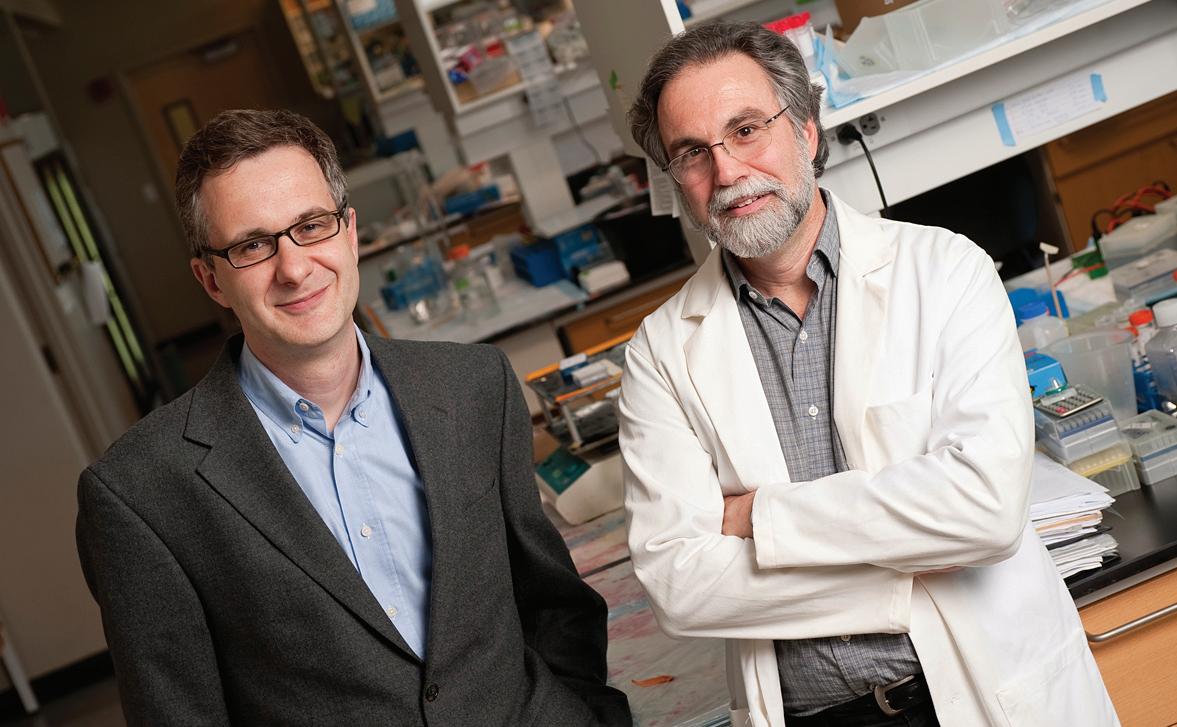
4 minute read
Bone from Stem Cells
Building Bone from Stem Cells
Bioreactor Could Propel Regenerative Bioreactor Could Propel Regenerative Medicine to the Next Level Medicine to the Next Level
Advertisement
Custom-designed perfusion bioreactor for cultivation of anatomically-shaped human temporomandibular joint (TMJ) bone grafts. Photo: Keith Yeager By JaCoB koSkIMakI
Regenerative medicine may offer hope for those afflicted with injury, birth defects or disease by having damaged tissues and organs replaced by those grown in cell culture. Yet, the complex biological and engineering challenges required for making a functional organ in a laboratory have limited advancements in the field. Using a specially designed bioreactor and stem cells harvested from a patient’s own body, Warren Grayson, an assistant professor of Biomedical Engineering at Johns Hopkins University School of Medicine, may have cleared a hurdle on some of those limits to grow one of the most complex joints in the human body.
Grayson, an affiliated faculty member of Johns Hopkins Institute for NanoBioTechnology, and his colleague Gordana VunjakNovakovic from the Columbia University Laboratory for Stem Cells and Tissue Engineering, designed a method for using stem cells to grow a biologically viable temporomandibular joint (TMJ) The TMJ is the joint linking the jaw to the base of the skull. The method, developed prior to Grayson joining the Johns Hopkins faculty, uses a bioreactor design that can be tailor-made to the anatomy of individual patients.
At the world’s first TMJ conference in 2006, it was reported that TMJ disorders affect nearly 25 percent of the population, yet current methods to correct defects are limited to autologous tissue grafting, where bone is transplanted from one part of the body to another. This method requires harvesting tissue elsewhere in the body and is painful and invasive for patients. According to Grayson, “other approaches, such as injecting bone marrow or stem cells directly into damaged regions, are severely limited in their ability to regenerate large bone defects.” Synthetic materials have shown promise, yet remain difficult to integrate with host tissue. Engineering scaffolds that allow for host cells to regrow may be the best way to integrate engineering design with the body’s own cells and ability to heal.
Grayson’s approach uses patientderived adult stem cells, and a scaffoldbioreactor system. The bioreactor is essentially a mini-biological ‘womb’ mimicking the physiological environment required for development allowing cells to develop into viable structures.
“Bioreactors train cells to form functional constructs through the application of tissue-specific biophysical and biological cues,” he explains. By carefully providing
growth factors, mechanical forces, and temperature/pH control, the cells can grow into a new physiologically-viable TMJ bone graft, which Grayson hopes will one day be used for implantation in patients. Published in the Proceedings of the National Academy of Sciences, his early studies have shown healthy bone cells and mineral deposition, indicating they are “fully osteogenic;” that is, expressing the proteins and genes sufficient for implantation.
The thing that sets Grayson’s bioreactor apart is that the grafts cultivated can be geometrically accurate and patientspecific. Using high-resolution data from computerized tomography to define exact dimensions and shape of the joint and cells harvested directly from patients, this method can be used to tailor bone grafts to each patient’s unique anatomy.
“Geometry is a big part of their function. This affects how they articulate with neighboring bones and is a significant component affecting how the joint actually performs,” Grayson says. Aside from patient-to-patient variation, the TMJ has a complex shape, and reconstructing it serves as a proof of principle that this technique could be employed to develop other bone constructs, each of unique anatomy and size. This technique may be especially advantageous for patients with facial trauma, where appearance is a primary concern. Being able to provide anatomicallyshaped grafts would be a considerable advantage that would change how these patients are currently treated, Grayson explains.
Grayson’s lab also researches basic stem cell biology, trying to understand exactly how populations of stem cells develop into multi-cellular tissues by creating novel methods to alter the signals the cells see at different points in the bioreactors and over the cultivation period. Varying such conditions can impact how different cells within the constructs organize themselves into hierarchical structures similar to healthy bone tissue. Understanding stem cell constructs for bone will allow expansion to other tissues such as cartilage, which also can be grown in bioreactors in tandem with bone and which could potentially lead to the growth of entire biological joints, Grayson suggests.

Grayson hopes his constructs will bridge the gap between basic biology studies of stem cell properties and translational clinical research. He also has started using mathematical models to better understand and more finely tune the complex developmental process in making functional bone tissue from stem cells. The next step, he says, is to test the joints in animals to determine host integration with tissues before moving to clinical testing. ®
TMJ encircled. Image: Grayson Lab Warren Grayson, Assistant professor, biomedical engineering.

Jacob Koskimaki is a NanoBio IGERT doctoral fellow in biomedical engineering working in the Popel Lab.










